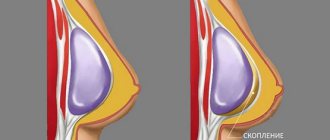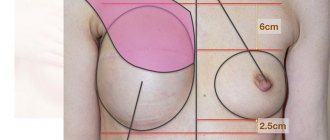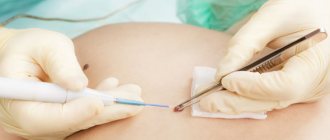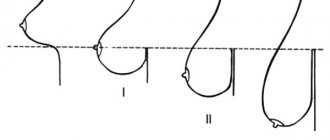Breast augmentation is the most common plastic surgery, accounting for 22% of all surgical procedures in the United States, and 16-18% in Russia and Germany. This fact alone indirectly indicates the relative safety of mammoplasty, which is confirmed by data from current medical research and statistics from the International Society of Aesthetic Plastic Surgery (ISAPS)
.
Modern implants, unlike those used 30 years ago, are made from non-toxic silicone and a durable cohesive gel that does not harm the woman’s body. Most major manufacturers, such as Allergan and Mentor, provide a lifetime warranty on endoprostheses, which means that if they are accidentally damaged, unrelated to external physical impact or complications, the company will replace them free of charge. It is worth noting that such cases are rare. Plastic surgeons of the clinic named after. N.I. Pirogov in St. Petersburg has accumulated many years of experience in aesthetic and reconstructive operations on endoprosthetics of the mammary glands, lifting, reduction mammoplasty, etc. Thanks to the modern material and technical equipment of the clinic and the high professionalism of plastic surgeons, such operations are carried out at all stages (from initial consultation to complete recovery) for our patients it is comfortable and without complications. Answering the question of how dangerous breast augmentation surgery is, we can point out the risks
(they exist, as with any surgical intervention) and methods for solving problems that theoretically can be encountered.
Hematoma (collection of blood) after breast lift
Occurs in 1 - 3% of cases from all operations, develops on the first day after surgery. The hematoma does not go away on its own, as it
a sufficiently large accumulation of blood that cannot resolve on its own.
It is treated promptly; the essence of the operation is to remove blood clots.
If the hematoma remains unrecognized, this can lead to suppuration of the wound, disruption of the blood supply to the skin-fat flaps, etc. Therefore, the hematoma requires the closest attention.
More about hematoma
Problems after unjustified mammoplasty
COVID-19✓ Safe
After mammoplasty, the patient is usually discharged home the very next day after the operation, and sometimes, if her condition does not cause any concern, on the same day. During the first few days after surgery, a woman may feel tension in the skin at the operation site, swelling and redness of the skin. 2-3 days of moderate pain in the surgical suture area is absolutely normal and you should not be alarmed. Within a week, swelling and bruising disappear, the pain goes away completely. For another month, the woman needs to wear special post-operative compression garments that keep her breasts in good shape. A week after the operation, the woman can already return to work, but she is advised to avoid heavy loads, otherwise complications may occur.
Of course, if a woman strictly follows the recommendations received from the surgeon, then complications are minimal. However, there are complications that are not always the fault of the woman herself. Among the most common are subcutaneous hematomas (the risk of their occurrence is especially high if the patient has used nicotine), inflammatory changes in soft tissues (if the woman has a weak immune system), the occurrence of hypertrophic scars (as a rule, nature itself is “to blame” for this, because there is a certain type of people whose skin is predisposed to the appearance of such scars), contracture of implants and prostheses - the formation of a scar capsule around the implant (also an individual feature).
Complications that arise after mammoplasty can be divided into 2 large groups - those that arise in the early postoperative period and late ones, which can manifest themselves later after the operation.
EARLY COMPLICATIONS
Early complications occur 2-3 weeks after surgery. If the surgeon is sufficiently qualified, if the patient was properly examined, if the operation was performed according to the principle of minimal trauma, taking into account all necessary conditions (for example, in the middle of the menstrual cycle, against the background of a ban on nicotine, alcohol, anticoagulants, etc. .) – the frequency of such complications is relatively low, no more than 4%. The most common early complications are hematoma, lymphorrhea and various suppurations.
A hematoma is an accumulation of blood in the cavity of the pocket around the implant (if the operation was for breast augmentation), or in the tissues of the mammary gland. The causes of this complication can be either secondary postoperative bleeding, a sudden increase in blood pressure or any injury in the postoperative period. As a rule, high blood pressure or its frequent jumps are one of the contraindications to mammoplasty, or perhaps the patient violated the doctor’s ban and took drugs that affect blood clotting.
Most often, a hematoma manifests itself already on the first day after surgery, usually developing on one side. Its first symptoms are a sharp increase in the volume of the mammary gland, the appearance of pain, the appearance of bruises and bruises along the edges of the mammary gland, as well as an increase in temperature to 38 degrees or higher.
If the patient in the acute period does not receive any treatment - neither conservative nor surgical (if there is a large hematoma, it is more advisable to resort to surgical removal), then the woman develops inflammation or suppuration, which will require removal of the implant and long-term treatment.
How can this condition be prevented? The examination that any patient undergoes before mammoplasty necessarily includes not only a general and biochemical blood test, but also a blood coagulation test. Identification of abnormalities in the blood coagulation system during examination is an absolute contraindication to surgery, and if the patient knew about this and deliberately took such a step, then the surgeon is not at fault here.
As already mentioned, a hematoma can occur due to the patient taking anticoagulants - drugs that affect blood clotting, or other drugs, the ingredients of which may in one way or another contribute to the formation of blood accumulation.
Mammoplasty is traditionally performed in the middle of the menstrual cycle, because... It is during this period that a physiological decrease in blood clotting is observed. If the operation is performed at the request of the patient during menstrual bleeding or shortly before its appearance, the appearance of a hematoma can practically not be avoided.
Some patients neglect the surgeon's recommendations and refuse to wear special compression garments or use elastic bandages in the postoperative period, while their use, as well as the use of local cold immediately after surgery, is an excellent prevention of the development of secondary bleeding and hematoma. The same applies to factors that increase blood pressure - physical and emotional stress, factors of vasodilation - thermal procedures and physical injuries to the mammary glands.
Lymphorrhea (aseptic inflammation) is a complication that results in the accumulation of lymph or serous fluid (seroma) in the cavity of the mammary gland or around the implant.
Aseptic inflammation is the response of tissues that react to the implant as a foreign body. Serous fluid accumulates in the cavity of the pocket surrounding the implant. Very often, such a reaction is observed in patients with increased tissue reactivity and metabolic disorders (for example, diabetes mellitus). Like hematoma, lymphorrhea most often occurs on one side and has similar manifestations, with the exception of bruising. With lymphorrhea, there is also an increase in temperature to 38 degrees and above.
The fight against complications consists primarily of installing drainage and suctioning excess fluid from the cavity. Local and general anti-inflammatory therapy is also carried out. If the patient does not receive any treatment, if an infection occurs, suppuration may develop, followed by removal of the implant.
Preoperative examination helps to identify certain diseases in which there is a high risk of developing aseptic inflammation and to refuse mammoplasty. The implant being installed is very important - size, type, structure, type, quality, manufacturer, etc. If the patient receives the prescribed antibacterial treatment, avoids thermal procedures and physical trauma to the breast, as a rule, it is possible to reduce the risk of possible complications to a minimum.
Suppuration is a complication accompanied by the addition of a seroma (aseptic inflammation) or an extensive hematoma that was not removed. As a rule, the cause of suppuration is the addition of an infection to an already existing inflammatory process. If suppuration develops, as a rule, a decision is made to remove the implant and carry out long-term complex treatment. Only after a year is a decision made about the possibility of re-installing the implant.
LATE COMPLICATIONS
Some patients may have problems with the healing of postoperative scars: if the skin around the scar is thin, then a second operation will most likely be required, but before that the skin must be allowed to heal.
Several years after surgery, the breast may become somewhat firmer, and this may most likely be due to capsular contracture. In this case, a second operation is performed, during which the capsule is opened, partially removed, and the implant is placed back in the pocket.
Quite rare, but “moving” of implants occurs, due to which they acquire an asymmetrical arrangement. This is usually corrected with repeated surgery.
In most cases, the development of complications is caused either by the patient’s inattention to following the recommendations of the doctor supervising her, or by an inadequate and incomplete examination before mammoplasty, during which risk factors that led to the development of complications were not identified.
The clinic’s specialists will be happy to help all women who are planning to use modern plastic surgery to make their breasts young and beautiful. We will not only conduct a full clinical examination - instrumental diagnostics and clinical laboratory tests that you will need before this operation, but will also give you a full detailed consultation with a mammologist with a detailed explanation showing the full picture of your health. With this conclusion, all you have to do is mentally prepare for the operation and choose a doctor who will make your dream come true.
Telephone
Swelling of breast tissue after mastopexy
After surgery there is always swelling. It is especially pronounced in the first three days and is associated with tissue trauma during surgery and fluid retention. The main swelling disappears during the first two months after surgery as the damaged vessels are restored.
If the swelling does not subside within two weeks, then this becomes a problem that needs to be addressed.
Causes of persistent swelling:
- refusal of compression garments;
- thermal exposure (sauna, bath, beach)
- early physical activity.
Features of breast augmentation surgery and contraindications
We have previously written about the types of implants, their texture and composition. At the initial consultation, the plastic surgeon will help you decide on the appropriate shape (round or anatomical), size and method of installation (type of access). Currently, preference is given to implants with a textured surface made of polyurethane or silicone. Their shell is particularly durable and does not slip in the capsule, which reduces the risk of displacement of the prosthesis. In addition, recent studies have shown that silicone implants with a textured surface reduce the likelihood of capsular contracture, a complication that we will discuss below.
Before breast augmentation surgery, it is necessary to undergo a mandatory hardware examination, take tests and consult with doctors: a plastic surgeon, therapist, mammologist, anesthesiologist. At this stage, risks and contraindications are identified, which you can learn more about in this article.
Breast replacement surgery is performed under general anesthesia. The average duration of surgery is 1.5 hours. For 1-2 days, depending on the individual characteristics of the body, the patient is under the supervision of a doctor and nurses, and then can be discharged from the clinic home. During the rehabilitation period, you must follow all the recommendations of the plastic surgeon. For example, it is important to wear special compression garments and avoid physical activity, baths and solariums for the period prescribed by the doctor.
Decreased sensitivity of the nipple, areola and surrounding skin
In the first weeks after surgery, a decrease in sensitivity is expected due to damage to nerve endings. Over time, the nerve endings are restored and sensitivity returns.
This also occurs when large amounts of glandular tissue are removed during breast lift and reduction surgery. With this operation, the damage to the nerve endings is more significant. Over time, skin sensitivity is restored, but due to more significant tissue damage, sensitivity may not be fully restored.
Experience shows that a slight decrease in sensitivity occurs in a small number of patients, but does not cause significant discomfort.
Complications after breast surgery can be divided into two groups:
- General surgical. Early: inflammation, bleeding, suture failure. Late: 1) subcapsular contracture. After the implant is implanted, a connective tissue capsule is formed around it. Under certain conditions, the capsule may become too dense and begin to shrink. The compressed shape and density of the implant change, which is reflected in the appearance of the breast. Correction of the resulting defect is possible with repeated surgery. The manufacturing technology of modern implants is aimed at ensuring that the capsule is formed as thin as possible and as quickly as possible, which significantly reduces the likelihood of contracture formation. 2) seroma – serous intercellular fluid around the implant. Formed due to the formation of a cavity that is too large. Eliminated by surgical correction.
3) decreased sensitivity of the nipple-areolar complex . The incidence is about 21%. 4) changes in the skin of the breast , wrinkling, hardening like a lemon peel. Occurs when the rehabilitation regime and individual characteristics of the skin are violated, and is subject to treatment and correction. - Aesthetic. The result of the operation does not partially or completely meet the patient's expectations. This occurs due to the fact that during the consultation the client was unable to convey to the surgeon his wishes for the result, or was not completely sure of what he needed. A responsible approach to the issue of changing your appearance, thinking through and taking into account all the nuances, minimizes the likelihood of such a situation occurring.
Vein thrombosis in the legs
Belongs to the category of general surgical complications. The essence of the complication is the formation of blood clots in the deep veins of the lower extremities. The rupture of a blood clot can lead to very serious consequences.
To prevent the development of this complication, women who smoke should stop smoking two days before surgery. Taking birth control medications also increases the risk of thrombosis, so you should tell your doctor if you are taking these medications.
In addition, before the operation, the clinic carries out a set of preventive measures aimed at preventing such complications.
How long does the discomfort last?
We have already said how long the swelling lasts after surgery, but the discomfort may lie in other symptoms. This is pain, discomfort and a host of other subjective problems. The duration of rehabilitation varies depending on the recovery abilities of the body of each individual patient, careful adherence to the surgeon’s recommendations and a number of other factors. On average, any discomfort disappears after about two months: it is during this time that swelling disappears without a trace. To help the body recover, you will have to strictly follow all the doctor’s prescriptions and regularly appear for examination. If the discomfort does not go away for more than two months, this is a reason to immediately go to the surgeon and inform him about it. Otherwise, complications may occur that will lead to displacement of the implants and loss of aesthetics.
Repeated ptosis of the mammary glands
Over time, breasts naturally sag. This is due to a gradual change in the quality of soft tissues and the effect of gravity. Regardless of the lifting technique chosen, after surgery the new mammary gland will continue to descend, maintaining the correct position of the nipple-areolar complex.
Experience shows that size 3 breasts reliably maintain the results of a breast lift for 7-10 years. The greater the postoperative volume of the mammary glands, the stronger the secondary ptosis (sagging) of the breast will be. In some cases, size 5-6 breasts are almost impossible to maintain the correct shape for 5 years after surgery.
With mastopexy of breasts smaller than the third size, the result lasts almost for life.
Highly qualified surgeons, careful planning of the operation, precise markings and careful execution of the operation allow postoperative complications to be minimized.
Main symptoms of hematoma
- painful sensations
- the appearance of swelling, puffiness
- skin color change
- local temperature rise
- breast deformity
The incidence of hematomas depends on the chosen surgical method. If the implant is installed under the pectoralis major muscle, then the risk of hematoma formation in this case is 3 times higher than if the implant was installed under the mammary gland.
This is explained by the fact that when installing an implant under the pectoralis major muscle, the surgeon cuts through muscle tissue rich in blood vessels. While in the tissues of the interfascial space, which is affected when installing an implant under the gland, there are fewer such vessels.
As a rule, a hematoma develops during the first day after surgery, most often it occurs only on one side. Bruising appears on the mammary gland and adjacent areas. They are accompanied by an increase in the size of the mammary gland, pain and fever.
Why after mammoplasty you can’t play sports or lift weights?
During the first week, the muscles hurt even at rest. If you want to avoid excessive pain, avoid putting stress on your shoulder girdle in the first 2 weeks. If you want ideally shaped breasts, give up for 4-5 weeks. If you don’t want to have any problems, follow the rules of what not to do after mammoplasty breast surgery.
When contracting, the pectoral muscle pulls the implant along with it. And if you often raise your arms and load your chest in the first month, the implant will rise above the planned level. Moreover, the level of placement of the implants will rise unevenly - the right one for right-handers will be slightly higher than the left.
Don’t forget that regular walking or moderate exercise helps the body recover faster. Household chores can be done as soon as the pain subsides. And you will return to sports in 4-5 weeks, and the load in the gym should be increased gradually.
Diving, martial arts, spinning around a pole and other traumatic sports will become available 3-4 months after surgery, not earlier.
Causes of complications after mammoplasty
We will discuss the possible unpleasant consequences of surgical breast augmentation and methods for correcting them in the second part of the material, since from a practical point of view it is more important for the patient to know the reasons for which they arise.
There are many reasons; a mistake can be made at the planning stage. When breast augmentation occurs, one of the key issues is the choice of prosthesis. Many women initially decide to install a large implant because they want to increase their bust by two or even three sizes at once. Installing an implant that is too large and does not correspond to the anatomical features of the breast is one of the reasons for unpleasant consequences in the medium and long term.
Not least among the reasons for the development of complications after mammoplasty is the choice of an insufficiently qualified, inexperienced surgeon. Doctor's mistakes at the stage of planning the strategy and tactics of surgical correction, as well as during the implementation of plans during the operation, can lead to the development of not only aesthetic and functional, but also medical problems - suppuration, hematoma, breast edema, seroma formation.
The third group of reasons is neglect of basic recovery rules. Many complications after breast augmentation occur due to the fact that a woman does not wear compression garments, or wears them from time to time, inconsistently. Early expansion of physical activity (strength training, dancing, cardio, yoga) is another source of unpleasant consequences. Thermal treatments, visiting a solarium or relaxing on the beach, swimming in natural or artificial reservoirs in the first one and a half to two months after surgery - all this can also lead to the development of medical or aesthetic problems.
So, in order to prevent complications after mammoplasty or at least significantly minimize the risk of their development, an integrated approach to planning surgical correction is necessary. Prevention measures should include:
1. Rational approach to choosing an implant . Women with thin subcutaneous tissue, small breasts and some other structural features of the chest do not need to strive for the installation of a massive prosthesis. It is very important to listen to the surgeon’s recommendations in this matter.
2. Extremely careful selection of a specialist. Breast modeling can only be entrusted to a doctor with extensive experience, high qualifications and an impeccable reputation. Mammoplasty is a complex operation that requires a certain degree of skill from the surgeon.
3. Attention to all rules of the recovery phase. It is necessary to wear compression garments without removing them for 4 weeks. Intense physical activity is contraindicated, not only strength training, but also yoga, cardio, running, and jumping rope. You can’t even swim in the pool, you can’t sunbathe, you can’t take hot baths or resort to other thermal procedures.
Another recommendation concerns an adequate assessment of the current condition of the mammary glands. For patients with signs of age-related or post-lactation ptosis, installation of a large implant without a bust lift is not recommended. Due to a decrease in skin elasticity and stretching of the ligamentous apparatus, the risk of implant displacement increases with increased manifestations of mastoptosis. It is advisable to carry out a complex correction - installation of a prosthesis simultaneously with mastopexy.
Why do many people say that you can’t sunbathe after mammoplasty?
Sunburn scars can lead to hyperpigmentation. Sun exposure significantly slows down the healing process. You can sunbathe, but post-operative stitches should be covered from the sun.
You will have to abstain from baths and saunas for some time. Warming up provokes various infections. A month after the operation, visiting the sauna is allowed, but reason and logic must be present in all actions. Allowed does not mean sitting in the steam room for hours. Excessively overloading your body is something that definitely cannot be done after any operation, not just mammoplasty.










